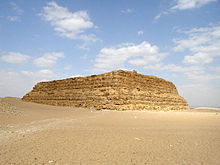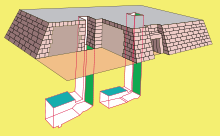- Mastaba
-
A mastaba, or "pr-djt" (meaning "house for eternity" or "eternal house"), is a type of ancient Egyptian tomb in the form of a flat-roofed, rectangular structure with outward sloping sides that marked the burial site of many eminent Egyptians of Egypt's ancient period. Mastabas were constructed out of mud-bricks or stone.
Contents
History
The greatest stimulus for the ancient Egyptians was their belief in an afterlife. This was reflected in their architecture and most prominently by the enormous amounts of time, money, and manpower involved in the building of their tombs.[1] “Egyptians believed that the soul could live only if the body was preserved from corruption and depredation.”[2] From the predynastic era forward, the ancient Egyptians strove to develop methods for preserving the bodies of the dead. Initially embalming methods were used, and later architectural tombs were devised to preserve the corpse indefinitely.[3] The body would be placed in a deep, sealed chamber such as a Mastaba. The remains were not in contact with the dry desert sand, consequently natural mummification of the remains could not take place. In order to preserve the remains, the ancient Egyptian priests had to devise a system of artificial mummification. [4]
Structure
The word Mastaba comes from the Arabic word for a bench of mud,[5] likely because when seen from a distance it resembles a bench. Inside the mastaba, a deep chamber was dug into the ground and lined with stone or bricks. The exterior building materials were initially bricks made of sun dried mud which was readily available from the Nile River. Even as more durable materials of stone came into use, the cheaper and easily available mud bricks were used for all but the most important monumental structures.[6]
The above-ground structure was rectangular in shape, had sloping sides, a flat roof, was about four times as long as it was wide, and rose to at least 30 feet in height. The mastaba was built with a north-south orientation. This above ground structure had space for a small offering chapel equipped with a false door to which priests and family members brought food and other offerings for the soul of the deceased. A second hidden chamber called a "serdab" (سرداب), from the Arabic word for “cellar,” housed a statue of the deceased that was hidden within the masonry for its protection. High up the walls of the serdab were small openings. These openings “were not meant for viewing the statue but rather for allowing the fragrance of burning incense, and possibly the spells spoken in rituals, to reach the statue.”[7]
Architectural evolution
The mastaba was the standard type of tomb in pre-dynastic and early dynastic Egypt for both the pharaoh and the social elite. The ancient Egyptian city of Abydos was the location chosen for many of the cenotaphs. The royal cemetery was at Sakkara, overlooking the capital of early times, Memphis.[8]
Mastabas evolved over early dynastic period. During the First Dynasty, mastaba was constructed simulating house plans of several rooms, a central one containing the sarcophagus and others surrounding it to receive the abundant funerary offerings. The whole was built in a shallow pit above which a brick superstructure covered a broad area. The typical of Second and Third Dynasty mastabas was the 'stairway mastaba', the tomb chamber of which sank deeper than before and was connected to the top with inclined shaft and stairs.[9]
Even after pharaohs began to construct pyramids for their tombs in the Third Dynasty, members of the nobility continued to be buried in mastaba tombs. This is especially evident on the Giza Plateau, where hundreds of mastaba tombs have been constructed alongside the pyramids.[citation needed]
In the Fourth Dynasty (ca. 2613 to 2494 BC), rock-cut tombs began to appear. These were tombs built into the rock cliffs in Upper Egypt in an attempt to further thwart grave robbers.[10] Mastabas, then, were developed with the addition of offering chapel and vertical shaft. Fifth Dynasty mastabas had elaborate chapels consisting of several rooms, columned hall and 'serdab'. The actual tomb chamber was built below the south-end of mastaba, connected with a slanting passage to a stairway emerging in the center of columned hall or court.
By the time of the New Kingdom (which began with the Eighteenth Dynasty around 1550 BC), “the mastaba becomes rare, being largely superseded by the independent pyramid chapel above a burial chamber.”[11]
References
- ^ Hamlin, Talbot. Architecture through the Ages. New York: Putnam, 1954. p.30.
- ^ Badawy, Alexander. Architecture in Ancient Egypt and the Near East. Cambridge: MIT P, 1966 p.46.
- ^ Hamlin, Talbot. Architecture through the Ages. New York: Putnam, 1953. p.30.
- ^ Ancient Egypt and the Near East. Cambridge: MIT P, 1966. p.7.
- ^ Gardiner, A (1964): Egypt of the Pharahos, p. 57 n7, USA: Oxford University Press.
- ^ R., C.L. “A Model of the Mastaba-Tomb of Userkaf-Ankh.” Metropolitan Museum of Art Bulletin, 8, (1913): 125-130. Metropolitan Museum of Art with JSTOR. 23 Apr. 2009 <http://www.jstor.org/stable/3252928>.
- ^ Arnold, Dorothea. When the Pyramids were Built: Egyptian Art of the Old Kingdom. New York: Metropolitan Museum of Art, 1999. p.12.
- ^ Fletcher, Sir Banister. A History of Architecture, 20th edition
- ^ Fletcher, Sir Banister. A History of Architecture
- ^ R., L.E. “Two Mastaba Chambers.” Museum of Fine Arts Bulletin, 8.45, (1910): 19-20. Museum of Fine Arts, Boston with JSTOR. 23 Apr. 2009 <http://www.jstor.org/stable/4423469>.
- ^ Badawy, Alexander. Architecture in Ancient Egypt and the Near East. Cambridge: MIT P, 1966. p.51.
Categories:- Arabic words and phrases
- Monument types
- Ancient Egypt
- Burial monuments and structures
Wikimedia Foundation. 2010.



